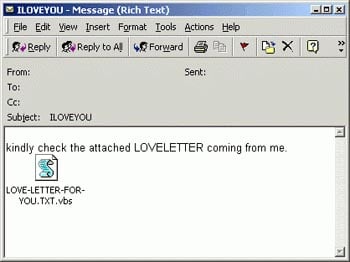7 of the most notorious computer viruses of all time
While today’s malware threats are dominated by headlines of spyware, ransomware, digital espionage and extortion, the history of cybersecurity and malware hasn’t always been this way.
We take a look at seven of the most notorious computer viruses (and other types of malware) throughout history, from the most destructive to the most famous (or notorious!)
ILOVEYOU

The ILOVEYOU worm-like virus, like many examples of modern malware, was spread primarily through email attachments. Created by Reonel Ramones and Onel de Guzman back in 2000, the virus took advantage of a flaw whereby email clients would automatically hide certain file extensions of attachments, allowing a malware author to create a file that looked like one type of file but was actually another type of file.
As such, the ILOVEYOU attachment looked like an innocent “love letter” TXT file (that usually opens in Notepad) that was designed to pique the interest of the recipient. In reality it was a type of executable file capable of infecting a device with the ILOVEYOU virus. Upon infection the virus would send itself to the email addresses on the infected devices address book (thus spreading itself) as well as overwrite files on a device, rendering the device unbootable.
It is considered one of the first viruses to owe its success to modern-day social engineering techniques – the promise of reading a love letter – to lure recipients into opening a dangerous attachment. So successful was the virus it managed to infect an estimated 10% of Internet-connected machines, resulting in around $10 billion in damages.
Its authors were never charged with a crime due to a lack of relevant cybercrime legislation at the time.
Sponsored Content. Continued below...
Melissa

Written in 1999 and, as the story goes, named after a stripper in Florida, this malware also spread via email, and used malicious Word document attachments and basic social engineering tricks to lure recipients into opening those attachments. Written by David Smith, the Melissa malware would use Macros embedded in Microsoft Word documents to infect devices – which many modern-day malware still does today.
Macros are pieces of code within a Word document that look to the Internet to download certain content, which by design is to allow a Word document to behave in a way that is could not do based upon its standard installation. However Macros can, and often are, exploited to download malicious code.
Upon infection, the Melissa malware would look for a Microsoft Outlook (email client) installation and send itself to 50 contacts in the address book if found. The malware originally began circulating after its author uploaded it to a Newsgroup claiming it contained passwords to adult websites.
Smith was sentenced to 10 years imprisonment but served only 20 months and paid a $5000 fine. He went on to help authorities identify and stop other types of computer malware.
WannaCry
The most recent addition to the list, the WannaCry malware in 2017 was a computer worm carrying a ransomware payload. It exploited a fatal (and possibly most prolific) flaw in cybersecurity – the willingness of many to use software that is long outdated.
The WannaCry malware was based on an exploit allegedly written by the National Security Agency called EternalBlue, which was subsequently leaked online. This exploit would target computers using the outdated Windows XP operating system. WannaCry spread largely in the Ukraine and Russia but also severely hit the UK’s NHS (National Health Service) network as well as a number of other businesses.
It was a computer worm and was able to spread between devices in a network without human interaction, providing those devices were running an unpatched and/or outdated operating system rendering them vulnerable to the exploit.
Hundreds of thousands of devices were ultimately infected and the damage would likely have been a lot worse if a security researcher from the UK hadn’t stumbled upon a kill switch that prevented the malware from spreading further. WannaCry also led to Microsoft taking the unusual step of releasing a security patch for Windows XP despite the operating system falling well outside its support lifecycle.
Experts believe the malware originated from North Korea.
Click for the next page below.
Keep up-to-date with all our latest articles. Follow us on Facebook, Instagram and Twitter.
Continued below...
Thanks for reading! But before you go… as part of our latest series of articles on how to earn a little extra cash using the Internet (without getting scammed) we have been looking into how you can earn gift vouchers (like Amazon vouchers) using reward-per-action websites such as SwagBucks. If you are interested we even have our own sign-up code to get you started. Want to learn more? We discuss it here. (Or you can just sign-up here and use code Nonsense70SB when registering.)
Become a Facebook Supporter. For 0.99p (~$1.30) a month you can become a Facebook fan, meaning you get an optional Supporter Badge when you comment on our Facebook posts, as well as discounts on our merchandise. You can subscribe here (cancel anytime.)

